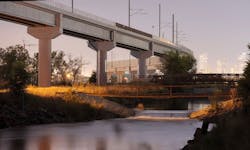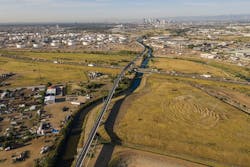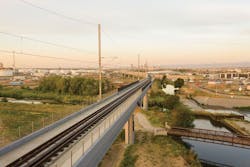NO. 6. BRIDGE: North Metro Rail Line Skyway Bridge
Back in 2004, voters in Denver approved a Regional Transportation District (RTD) plan to expand transit across the city’s metro area, which became known as the FasTracks program.
Since that time, the RTD has built 122 miles of new light and commuter rail, 18 miles of bus rapid transit, and 57 new transit stations throughout the Denver metro area. One of the recent results of the FasTracks program is the North Metro Rail line, a 13-mile electric commuter line designed to provide much-needed rail access between the city’s northern suburbs—including Commerce City, Northglenn, and Thornton—all the way to Denver’s Union Station downtown.
As part of the North Metro Rail line’s construction, the RTD had to build the Skyway Bridge, a 1.8-mile curvilinear structure with 64 prestressed concrete girder spans. “The North Metro Skyway Bridge came about because the alignment of that line weaves through some pretty developed industrial areas north of Denver,” Jim Bader, P.E., engineer of record for Stantec, told Roads & Bridges. “So the idea of the bridge was found to have the least amount of impact on the local communities, and just provide the overall safest option. So with that bridge we were able to expand over a lot of the existing development, rather than impact it.”
The scope and scale of the project presented a few considerable challenges for Stantec as lead designer for the bridge. On this project, using direct fixation combined with continuously welded rail on a curved structure of this length required an innovative design. Typically, many rail bridges have been built with ballasted construction track. But this approach, according to Bader, would have added a significant amount of weight to the structure, limiting span length capabilities. It also would have required extensive long-term maintenance for the ballast and rail alignment. With a direct fixation approach for the rail bridge, the track is directly fastened to the concrete deck, which eliminates the ballast entirely. “The advantages there are that the rail is held tight with the direct fixation fastener which provides a smoother ride and less maintenance in the long run,” Bader said. “And it also reduces a lot of weight on the structure so that we can really maximize those span lengths and avoid impacts in the construction.”
To account for complexities in the design, Stantec developed a 3-D finite element analysis model of the entire bridge to capture the complex curvatures, along with potential rail issues and alignments. The 3-D model was also set up to account for the complex interaction between the rail and the bridge structure due to the difference in thermal properties between the steel rail and the concrete structure. It also gave the team a clear picture of the stresses that would be introduced in the rail itself. Finally, the 3-D model allowed the designer to account for an extreme case of a rail breaking so the team could best figure out how to prevent the likelihood of a train derailment in such an instance.
In order for the bridge to have minimal impacts to existing facilities, the bridge deck needed to be up to 50 ft above grade at its highest, and have up to 170-ft max spans with the distance between deck joints up to 600 ft. These requirements resulted in more challenging design loads due to heavier commuter rail vehicle criteria.
At the time of its completion earlier this year, the Skyway Bridge became the longest bridge in Colorado and is among the longest direct-fixation bridges in the U.S. With this size of a project getting done on an accelerated schedule, the design needed to be simple, efficient, and easily constructible to minimize fabrication and construction time. “This portion of the project was on the critical path so that the design needed to be done in an efficient manner, to minimize the construction time,” Bader explained. “So when we worked on this, we wanted to standardize as much of the bridge elements as possible for efficiency of construction.” Barely a year had passed between when Stantec first began design work and when groundbreaking occurred for the first bridge foundation. But the team delivered the foundation packages before the rest of the bridge so construction could get underway while design work continued incrementally to fit the construction sequence.
From a safety perspective, this rail bridge avoids at-grade crossings to benefit the local community and to allow the trains to operate independently from the rest of the traveling public. The long bridge also minimized impacts to the robust industrial area in Denver’s metro region, as well as an existing power plant, treatment facility, rivers and creeks, highway crossings, utilities, and more.
The Skyway Bridge project was completed in early 2019, and the North Metro Rail line is currently in its testing phase with an anticipated public opening in May 2020.


